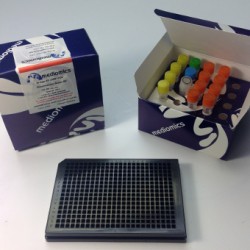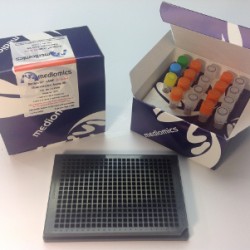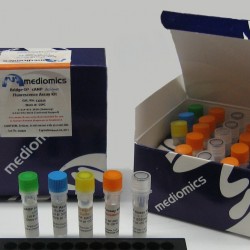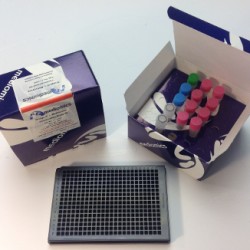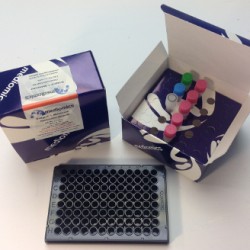Showing 7–12 of 45 results
-
Bridge-It® cAMP-Phosphodiesterase (PDE) Assay Kit, 384-well format
Bridge-It® cAMP-Phosphodiesterase (PDE) Assay Kit, 384-well format
The Bridge-It® PDE Assay is a fluorescence-based, high-throughput screening (HTS) method for measuring cyclic nucleotide phosphodiesterase activity from a purified source and determining the IC 50 of their inhibitors. This assay is based on the format of Bridge-It® cAMP all in one Fluorescence Assay (Mediomics, Cat# 122938).
Adenosine-3’,5’-cyclic monophosphate (cAMP) is an important second messenger which is involved in the modulation of numerous biological processes. The measurement of cAMP is especially important in new drug discovery since cAMP levels are closely related to the activity of one of the major targets for new drug discovery – the G protein-coupled receptors (GPCR).
-
Bridge-It® cAMP-Phosphodiesterase (PDE) Assay Kit, 96-well format
Bridge-It® cAMP-Phosphodiesterase (PDE) Assay Kit, 96-well format
The Bridge-It® PDE Assay is a fluorescence-based, high-throughput screening (HTS) method for measuring cyclic nucleotide phosphodiesterase activity from a purified source and determining the IC 50 of their inhibitors. This assay is based on the format of Bridge-It® cAMP all in one Fluorescence Assay (Mediomics, Cat# 122938).
Adenosine-3’,5’-cyclic monophosphate (cAMP) is an important second messenger which is involved in the modulation of numerous biological processes. The measurement of cAMP is especially important in new drug discovery since cAMP levels are closely related to the activity of one of the major targets for new drug discovery – the G protein-coupled receptors (GPCR).
-
Bridge-It® Cyclic AMP (cAMP) all in one Assay Kit, 384-well format
Bridge-It® Cyclic AMP (cAMP) all in one Assay Kit, 384-well format
The Bridge-It® cAMP assay is highly specific assay to quantify cAMP in stimulated cells. ATP, AMP, and cGMP have all been tested for selectivity using the cAMP assay. No response was detected using the Bridge-It® cAMP assay with any of these compounds within the concentration range that is expected in biological samples (i.e., millimolar range for AMP and ATP, and micromolar range for cGMP).
An all-in-one solution is added to activated cells and incubated for 30 minutes. Clarified lysate samples are transferred to a black 384-well microplate to read the fluorescence signal.
-
Bridge-It® Cyclic AMP (cAMP) Designer Assay Kit, 96-well format
Bridge-It® Cyclic AMP (cAMP) Designer Assay Kit, 96-well format
The Bridge-It® cAMP assay is a highly specific assay to quantify cAMP in stimulated cells. ATP, AMP, and cGMP have all been tested for selectivity using the cAMP assay. No response was detected using the Bridge-It® cAMP assay with any of these compounds within the concentration range that is expected in biological samples (i.e., millimolar range for AMP and ATP, and micromolar range for cGMP).
An all-in-one solution is added to activated cells and incubated for 30 minutes. Clarified lysate samples are transferred to a black 96-well microplate to read the fluorescence signal.
-
Bridge-It® L-Methionine (L-Met) Fluorescence Assay Kit, 384-well format
Bridge-It® L-Methionine (L-Met) Fluorescence Assay Kit, 384-well format
The Mediomics Bridge-It® L-methionine fluorescence assay method is based on a combination of well-established fluorescence measurement techniques and a new assay platform design that utilizes DNA-binding proteins as biosensors for their respective small molecule coregulators (ligands). The affinity of the DNA sequence-specific MetJ methionine repressor protein for its unique DNA binding site is greatly increased in the presence of its ligand, S-adenosyl methionine (SAM). For this assay, the MetJ consensus sequence was split into two approximately equal DNA “half-sites” with one half fragment labeled with fluorescein and the other half fragment labeled with Oyster® 645 fluorophore3,4. The relative amount of SAM present in a test sample will influence the amount of DNA-MetJ protein complex formation in the assay. When this complex forms, it brings the fluorescence labeled-DNA half-sites into close proximity and causes a measurable change (increase) in fluorescence signal emission that can be readily measured using a microplate reader (wavelength settings: absorption 485 nm; emission 665 nm).
-
Bridge-It® L-Methionine (L-Met) Fluorescence Assay Kit, 96-well format
Bridge-It® L-Methionine (L-Met) Fluorescence Assay Kit, 96-well format
The Mediomics Bridge-It® L-methionine fluorescence assay method is based on a combination of well-established fluorescence measurement techniques and a new assay platform design that utilizes DNA-binding proteins as biosensors for their respective small molecule coregulators (ligands). The affinity of the DNA sequence-specific MetJ methionine repressor protein for its unique DNA binding site is greatly increased in the presence of its ligand, S-adenosyl methionine (SAM). For this assay, the MetJ consensus sequence was split into two approximately equal DNA “half-sites” with one half fragment labeled with fluorescein and the other half fragment labeled with Oyster® 645 fluorophore3,4. The relative amount of SAM present in a test sample will influence the amount of DNA-MetJ protein complex formation in the assay. When this complex forms, it brings the fluorescence labeled-DNA half-sites into close proximity and causes a measurable change (increase) in fluorescence signal emission that can be readily measured using a microplate reader (wavelength settings: absorption 485 nm; emission 665 nm).

